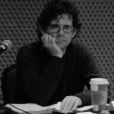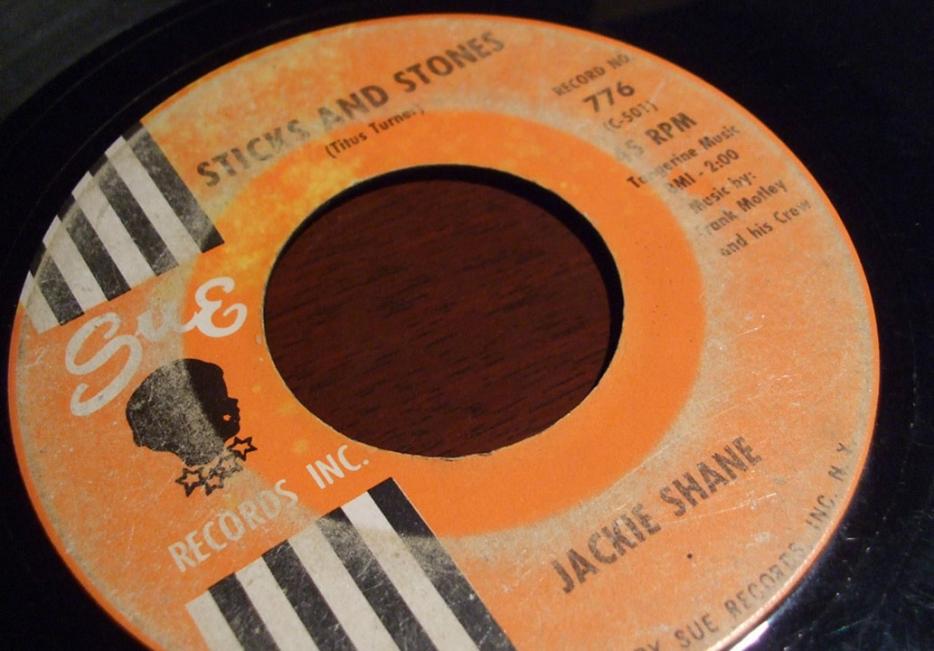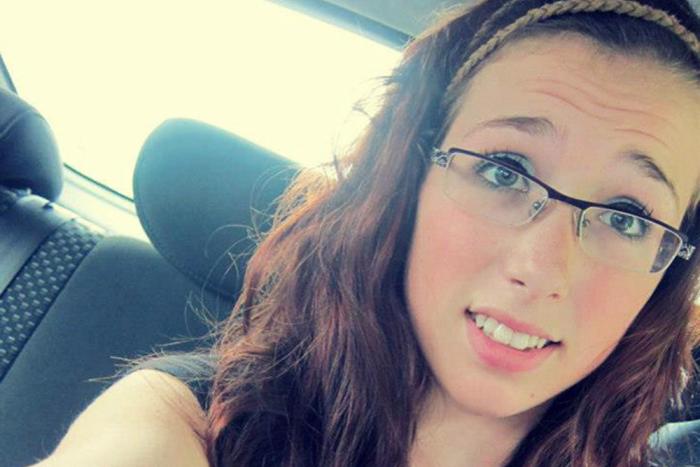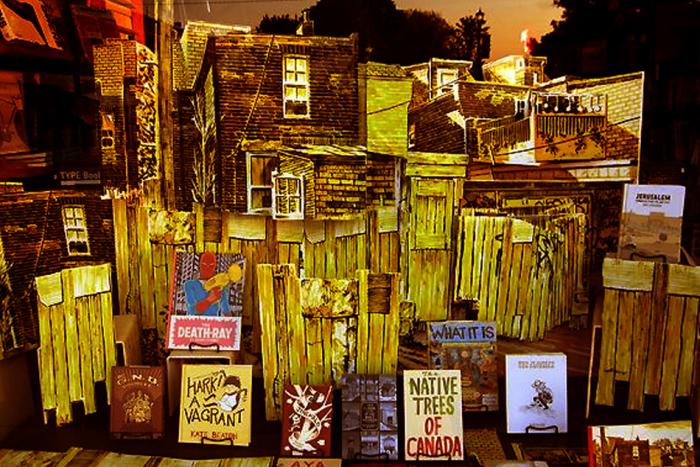Half a century ago this month, a local hit invaded Toronto’s radio charts at no. 2, sandwiched between “He’s So Fine” by the Chiffons and Skeeter Davis’s “The End of the World”—a rare enough thing in the time before Canadian Content regulations birthed a functional Canadian music industry. The song itself, though, was an even more exotic bird, a cover of an American rhythm-and-blues tune called “Any Other Way,” by Toronto-based artist Jackie Shane.
With its quavering, caressing vocals and that androgynous name (as in Jackie Robinson or as in Jackie Kennedy?), many casual listeners reportedly thought the song was by a woman. On the other hand, then-teenaged fan Carole Pope (later of Rough Trade) told me, “It was obvious to me and my friends he was gay.” Shane was in fact a drag queen who’d made his way to Toronto from Nashville and by that point had been enthralling crowds on the Yonge Street strip for a couple of years. That’s him you see above, in the only known film clip of his act, performing Rufus Thomas’s “Walk the Dog” on the Nashville TV show Night Train in 1965—as Pope said, “I love the little sweater he’s wearing, and I hope it’s violet.”
The key to Shane’s take on “Any Other Way” was that, live, he’d give a little chuckle or quip “make sure you tell her this!” before the chorus, “Tell her that I’m happy, tell her that I’m gay, tell her that I wouldn’t have it”—rimshot—”any other way.” What had been a face-saving fib by a brokenhearted guy in the original William Bell and Chuck Jackson versions became a wink of defiance from a queer tranny glad to have given denial the slip.
The Yonge St. scene was, along with the nascent bohemian coffee houses in nearby Yorkville, a patch of libertine hipness on Toronto the Good’s otherwise straight-laced map. (Even these clubs had to go at least nominally dry by 12 on Saturday nights, because the Lord’s Day Act forbade Sabbath drinking.) They hosted local R&B bands as well as touring groups in town to play Massey Hall or Maple Leaf Gardens: Cannonball Adderley, Stevie Wonder or James Brown’s band might drop by the Blue Note or the Colonial to jam after hours. But nothing was as hip as Shane, in shimmering pantsuits, heels and perfume, delivering the news from the future in the middle of a funky breakdown:
“You know, when I’m walkin’ down Yonge Street, you won’t believe this, but you know some of them funny people have the nerve to point the finger at me and grin and smile and whisper. But you know, that don’t worry Jackie, because I know I look good. And every Monday morning I laugh and grin on my way to the bank, because I got mine. I look good, I got money and everything else that I need. You know what my slogan is? Baby, do what you want, just know what you’re doing. As long as you don’t force your will and your way on anybody else, live your life, because ain’t nobody sanctified and holy.”
– spoken break in “Money (That’s What I Want),” Jackie Shane Live
Shane heated up Yonge St. for most of the decade: He and his band arguably taught the town how to play fatback bass. But in 1969-70 he abruptly told friends he had to leave Canada, and vanished, even before the loosening of burlesque rules transformed most of the Yonge clubs into nudie bars almost overnight in 1975. Neither his other singles nor the live album recorded at the Sapphire Tavern in 1968 ever reached the heights of “Any Other Way.”
For ages it seemed like the city had forgotten the Yonge St. scene in favour of the Joni-and-Neil Yorkville saga, aside from the recitation of how it gave the world Ronnie Hawkins and the Hawks, who met their boomer-rock destiny as The Band. But lately there’s been a bit of a revival, with director Bruce McDonald’s fine 2011 Bravo documentary Yonge Street: Toronto Rock & Roll Stories and, a bit earlier but less-noticed, Elaine Banks’ CBC Radio Inside the Music investigation I Got Mine: The Story of Jackie Shane.
Banks’s is the definitive work to date, among much else debunking the story that Shane was killed in a knife fight or bridge jump in the 1990s—one of Shane’s former bandmates talked to him on the phone at least as recently as 2005. (Another former Torontonian now in Britain, Jeremy Pender, claims to have spoken to Shane more recently, and that he now lives full-time as a woman, a position reinforced by at least one online witness. With hesitation I’ve decided to stick with the pronouns by which s/he was known during the Canadian stint.)
But most of the way the story gets told tends to imply Shane was an out-of-nowhere, one-of-a-kind phenomenon—the closest anyone could come up with at the time was Little Richard—thus the dubious rumour that Shane was the cousin of the gay rock pioneer, whose “Tutti Frutti” in its pre-recorded version was an exuberant ode to anal sex. There’s a risk of self-congratulation involved, as if Canada were so much more tolerant and evolved that Toronto served as a refuge. And maybe there is something to that. But if you follow the swishing train of drag performance in African-American life, and the shape of queer things to come post-Jackie Shane in Toronto, the script seems flipped: I think he brought us much more than we gave him.
THE BIG TENT
Jackie Shane was born around 1940 and—for reasons unknown but not hard to imagine for a queer teen in the black South of the time—spent some of his teen years living with Nashville “queen of the blues” and musical house mother Marion James. Elaine Banks guesses that he started performing and touring in his late teens, leading up to the day in 1960 when Frank Motley’s touring band picked him out of a crowd at Montreal’s Esquire Showbar. In Banks’s documentary, bassist Larry Ellis remembers that Shane mentioned playing “circus sideshows.”
That sparks thoughts of Southern black “tent shows,” traveling variety entertainments under canvas that could either be actual PT Barnum-style circus sideshows or just called circuses in themselves. Many were linked with itinerant patent-medicine sellers, independent theatre troupes, or touring companies representing nightclubs from the chitlin circuit—the network of clubs, bars, juke joints, fraternal lodges and other venues that made it possible for black entertainers to reach black audiences and travel in comparative safety from north to south. Most of the famous black entertainers of mid-century—from Count Basie to Richard Pryor—did time on the circuit before crossing over, while others spent whole careers there.
Whether in tent shows or circuit clubs, drag queens—known as female impersonators – were common. Little Richard himself played Princess LaVonne, balancing tables and chairs in her mouth, in a “minstrel” show (a term that held on long past its antebellum infamy) run by “Sugarfoot Sam from Alabam.” Richard was avowedly influenced by Esquerita, another piano player whose drag shtick was even more flamboyant and whose bouffant was even higher, and who enjoyed a brief R&B recording career when rival record companies were looking for Little Richards of their own. Both took after respected blues singer Billy Wright, a gay star in and out of drag from Atlanta who had regional hits in the late 1940s and was a dab hand with a makeup brush. Other R&B stars with backgrounds in drag likely included Rudy Ray Moore (later blaxploitation “pimp” star Dolemite), Bobby Marchan, Larry Darnell and many more.
Most of the way the story gets told tends to imply Shane was an out-of-nowhere, one-of-a-kind phenomenon. There’s also a risk of self-congratulation involved, as if Canada were so much more tolerant and evolved that Toronto served as a refuge. And maybe there is something to that. But if you follow the swishing train of drag performance in African-American life, and the shape of queer things to come post-Jackie Shane in Toronto, the script seems flipped: I think he brought us much more than we gave him.
The drag capital was New Orleans, with its polymorphous, masked-carnival tradition. The popular Dew Drop Inn was hosted for decades by beloved drag queen Patsy Vidalia, and Little Richard, a Dew Drop regular, found his recording mojo in Cosimo Matassa‘s French Quarter shop studio (“tutti-frutti, good booty!”). According to Louisiana music journalist Alison Fenterstock, “It’s clear empirically, in NO at least, that trans, openly gay or otherwise queer performers have historically enjoyed a special place in the black community here.” It was a town where the most popular straight funk band, the Meters, could cut a classic called the “Cissy [Sissy] Strut.”
“If you look at back issues of the Louisiana Weekly, NOLA’s historic black newspaper, from the 50’s,” says Fenterstock, “every nightclub ad includes [drag acts] as an opening act for the main musical performer—multiple different house groups of female impersonators, it looks like, each with its home base at a different club.”
She became familiar with this backstory chronicling the rise in the past decade of “sissy bounce” (a term she coined), the cross-dressing gay hip-hop style in New Orleans that’s made stars out of drag performers such as Big Freedia and Katey Red. They’re often said to appeal especially to women, who relish the chance to shake their thangs along with performers rather than for them. A particular connection with audience “gals” (as he’d call them) was a hallmark of Jackie Shane’s live presence, too, especially in his spoken-word interludes unpacking the appeal of songs of love gone wrong.
But it wasn’t just in NOLA. Preston Lauterbach, author of the recent study The Chitlin’ Circuit and the Road to Rock ‘n’ Roll, says that the demand for drag was clearly widespread, and “straight dudes” he interviewed for his book praised the talents of a Memphis queen named Peaches in particular. Louis Jordan’s “Caldonia“ was said to be a paean to a drag queen, just like Little Richard’s “Lucille” and “Long Tall Sally.” As historian Marybeth Hamilton writes in her 1998 essay, “Sexual Politics and African-American Music”: “Female impersonators were featured in many of the rhythm-and-blues package shows that toured the North and Deep South, scoring hits in the most unlikely places—Mobile, Alabama, for example… Pompadoured, effeminate, and raunchily funny.”
Check out these pages from Ebony magazine of March, 1948, preserved on a tribute page to Chicago drag queen Petite Swanson, profiling Joe’s DeLuxe nightclub on the South Side and its stable of “make-believe ladies.” Shane himself, even after his Toronto success, would sometimes decamp to tour with the Etta James Revue (with an uncertain connection to the real Etta James), an ensemble including cross-dressed entertainers who played circuit clubs.
How much deeper it goes depends on how many hours you have. Lynn Abbott and Doug Seroff’s 2007 study Ragged but Right: Black Travelling Shows, “Coon Songs” and the Dark Pathway to Blues and Jazz documents female impersonators in African-American tent shows back into the late 19th century. In New York meanwhile there was Frankie “Half-Pint” Jaxon, the Harlem drag balls, the “mannish acting women” among the early blues queens (Ma Rainey and Bessie Smith, also minstrel and tent-show veterans) and all the gender nonconformists of the jazz age and Harlem Renaissance.
Personally, the first drag performance I ever saw was black comedian Flip Wilson on TV in the early 1970s, with his ultra-popular, sass-talking character “Geraldine,” an archetype right out of the chitlin-circuit comedy where Wilson got his start. Geraldine is a cousin to the cornpone crossdressing practiced by Christian actor and director Tyler Perry today—his Madea plays and movies, huge in black America, are an enduring holdover, stripped of gay subtext, from a very old, broad, black comic style. Not everyone is thrilled by that.
[pagebreak]MAMMY, SAMBO, TRICKSTER, HUSTLER
That ambivalence hints at the multitudinous duplicities of crossdressing in African-American history. It’s difficult to separate it, for example, from the legacy of minstrelsy: Blackfaced white minstrel troupes were as a rule all-male, and so would include performers who specialized in female characters, mostly degrading archetypes such as the Mammy and the Wench (plantation madonnas and whores). When black-run minstrel tent shows and their female impersonators took over, they sometimes perpetuated those characters, though they also added more dignified ones, just as they sang some of the “coon” songs and re-enacted jokes and scenarios from that ugly past. Scholar J.T. Lhamon reads Little Richard’s act as a “Sambo” figure mutated, made a “trickster,” by its acceleration through rapidfire postwar social modes—sum that up as “woo!” or “A-wop-bom-a-loo-mop-a-lomp-bom-boom!” (those last couple of syllables were originally “goddamn!”).
Minstrelsy might be reclaimed and reconfigured, but its uneasy inheritance is everywhere, in American black and white.
Drag can also be hard to sort out from peacock-pimp stylizations that have likely more to do with cross-class impersonation—aspirations to wealth and masculine power, with the trappings of preachers’ robes and even high-status fashions looking back to Africa—than with gender-bending. Prince clearly manifests both, but would you have guessed, as R.J. Smith’s recent milestone biography of James Brown tells us, that Brown modeled his own style on Little Richard, Billy Wright and other “tent-show queens”? No one mistakes the Godfather of Soul as trying to look like a lady.
Drag might connect with the matriarchal line of black culture, but it doesn’t prove black communities less homophobic. Drag can serve as much for mockery as for idealization. As Fenterstock says, “Your average overtly queer black guy like, say, the mailman, did not and does not necessarily enjoy the same privilege” as the entertainer, even in New Orleans. Marybeth Hamilton, who reproduces the sign of a black rooming house that specifies “No Female Impersonators Allowed,” argues that the “freak” in early 20th-century black culture significantly diverged from the evolving idea of hetero and homo in the white world. In this working-class version, the “sissy” stood in for the destabilization of sexual identity that went along with the Great Migration from South to North, and country to city, when no one in the urbanizing black population quite trusted their roles, including the idea that a real guy could fuck a sissy in a pinch. Even a macho blues singer could drawl, “Woke up this morning with my pork-grinding business in my hand/ If you can’t bring me no woman, bring me a sissy man.”
The fluidity of identity and masquerade that drag represents does recall W.E.B. Du Bois‘s famous invocation of the “double-consciousness” inherent to black life: “born with a veil, and gifted with second sight in this American world… this sense of always looking at one’s self through the eyes of others. … One ever feels his twoness.” There might even be a more ancestral and metaphysical level, Fenterstock suggests, “attitudes from Africa and the Caribbean, where the gender-straddler often had a shamanic role,” shuttling between the material and the spirit world. She notes that those traditions “weren’t stifled as much in New Orleans as they were in the rest of the slave-owning South”—not to mention how suppressed they were by Christianity over the centuries for European-descended whites like most of Jackie Shane’s Toronto audience.
Less romantically, the chitlin circuit and the tent shows existed—like so much African-American self-directed commerce and culture—on the margins of legality and respectability, as Lauterbach amply shows, often dependent on gambling, bootlegging, pimping and other underworld entrepreneurialism. If female blues singers often doubled as prostitutes, or were assumed to (the cruel import of glammy-pantsuited Mick Jagger’s line “I bet your mama was a tent-show queen” in the sexual-slavery NOLA fantasia Brown Sugar), what did that imply for a dance-hall tranny? Note these encouraging words from the Ebony article on Joe’s DeLuxe: “Joe’s rules are few, simple and inflexible to stay within the law. A female impersonator must be a good entertainer, must not wear dresses and makeup outside the club, and cannot accept invitations to sit at customer’s tables unless real women are present.”
That kind of policing assumes there’s something to guard against. Shane’s live monologues, in a town where cross-dressing in public was likewise illegal (which may be why he never wore skirts), also drop hints around hustling, perhaps just as a metaphor for making coin in the clubs, but perhaps not:
“Mother told me, she said, ‘Jackie,’ she said, ‘baby, I conditioned you,’ ha-ha, she says, ‘because you take after me – don’t worry about Daddy, because you’ll get paid for what Daddy has to pay for!’ And like always, Mother didn’t lie, honey. I’m getting it each and every day of my life. … I’m a little piece of leather, baby, but well put together. Ninety-eight on the seats and seventy-five on the sheets, and I got bedsprings on my bed singing Nearer My God to Thee. You know you got to have money to enjoy that kind of thing. … I don’t mean 50 or 60 dollars, I pay that for my French perfumes … [back into the song] … Baby if you wanna be mine, said you got to give me money baby.”
He needed the cash, Shane said, because he was about to go on a six-month holiday—and he didn’t want “to do nothin’ but have breakfast in bed brought to me by gorgeous chicken.” Chicken was of course gay slang for underage trade, often paid for, so at least Shane was expecting to have it both ways.
QUEERCORE CONFIDENTIAL
By now it should be obvious that Jackie Shane wasn’t bringing his act to Toronto so it could be better understood. Instead he was taking it out of context, to someplace where it seemed more alien and strange. Maybe he liked it better that way. By coming to Toronto he was escaping segregation and getting to perform to white people with presumably deeper pockets, who had never seen anything like him before. You could cross over in the States, but then you’d have to pull a Little Richard and turn your “freak” show into a clown act, taking out the gay innuendo. Little Richard has spent his life in an internal battle, betraying his gay self for his church self and then vice-versa. Maybe Jackie Shane was a subtler creature, or, I’m sad to think, maybe he wasn’t quite up to the competition.
After Toronto washed out—whether because of immigration officials, as I suspect, or club-scene changes, as Banks’s doc suggests, or because of the lack of any music industry to ascend in—there’s little word of Shane making a splash anywhere else. Whispers have it he became reclusive when he got back to Nashville. Maybe there were family issues. We might never know. Whatever the truth, I have a sentimental theory that his stay in Toronto, trailing all that history and drag-queen shamanistic magic, left something behind. Or at least uncorked it.
Carole Pope told me she didn’t count Shane as a direct influence. And of course queer culture in North America was undergoing a revolution in total in the 1970s. But I can’t help wondering if otherwise, a decade after Shane left town, Pope would have achieved a Top 40 hit with a band called Rough Trade and a song that fetishized a high-school Lolita making a hoarse-voiced female singer “cream my jeans when she comes my way.” Certainly, trans and queer themes were piping up the highway from punk New York, but they became surprisingly dominant in Toronto alternative art and music, from the days of the Miss General Idea Pageant and other queer happenings in early 1980s Queen Street West, through the queercore zine and punk culture that followed (JDs, Bruce LaBruce, Fifth Column, etc.), and even the crossover success of The Kids in the Hall, then into the 2000s with the Hidden Cameras, Final Fantasy (Owen Pallett), the late Will Munro‘s Vazaleen, and most recently the straight-but-queer-impersonating Diamond Rings, etc. There’s this impulse here to play queer for a larger, unsuspecting crowd and savour the confusion, like Jackie Shane did.
Can a nearly forgotten figure really be given credit? Likely not. But I choose to see him as a syncretic saint in this unsanctified pantheon. If Toronto can give more than their due to Neil, Joni, Robbie and others who passed through briefly en route to iconicity, why not to someone who wired up this backwater’s bland aesthetics to one of the most fucked-up, tangled and beautiful AC/DC power sources in North American culture, then stood back—all the way back, right off the map—to let it run?
Meanwhile in hip-hop and R&B, outside the safe zones of New York and New Orleans, there’s still a conflicted interplay between what kind of sexuality means just playing the “freak” role and what might be expressing some authentic self. Probable straight but definite Little Richardish clown Lil B calls an album I’m Gay to sew mischief, while Frank Ocean, Azealia Banks or Nikki Minaj come out but then dodge direct questions, and the likes of Missy Elliot and Queen Latifah, as rumours built, seemed to back away from music altogether. Given the borderline historical locations of the sissy man and the mannish-acting woman, it’s a balancing act harder than Chinese algebra. We’ve seen it in the tippytoe course of Barack Obama, endorsing gay marriage, backing off from it and then “evolving” to endorse it again.
Better to take these words from Jackie Shane: “I live the life I love and I love the life I live. I hope you’ll do the same. You know you’re supposed to live. … The mean things people say about you can’t make you feel bad, because Jackie can’t miss a friend that I’ve never had. [sings] I won’t have it, baby – [spoken] and I sing sexy too, that helps – [sings] no other way.”






